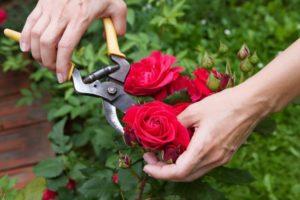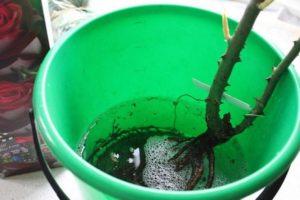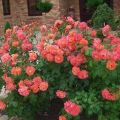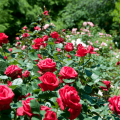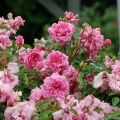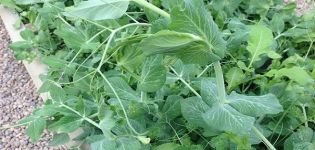Description of varieties of climbing roses for growing in Siberia, care and methods of reproduction
In regions with a mild climate, backyard and summer cottages are decorated with flower beds, alpine slides, on which lilies, primroses, and phlox are planted. Arches and arbors are entwined with climbing roses. From climbing plants create hedges. For growing climbing roses in Siberia, only varieties bred specifically for the unfavorable conditions of the northern territories are suitable. Heat-loving flowers are afraid of cold winds, do not tolerate severe frosts.
Features of growing roses in Siberia
Ornamental crops in harsh climates are usually not planted in open ground, but breeders are trying to create varieties of flowers that can be used to decorate flower beds in courtyards and parks in regions where the temperature drops below -30, but for the winter roses, lilies and peonies are carefully covered, and thermophilic bulbous the plants are dug up.
The best varieties for cold climates
Most of Russia is not suitable for planting ornamental crops. Accepted in Siberia, climbing roses grown in local nurseries endure severe winters. Cold-resistant varieties are bred by grafting cuttings onto an unpretentious rosehip, which is adapted to 40-degree frost.
Golden Celebration
The rose with flowers about 16 cm in diameter appeared thanks to the work of breeder David Austin. Golden Celebration variety looks great in the heat, is not afraid of the cold. A compact shrub up to 0.8 m in height slowly opens the buds, which do not fall off for a long time after abundant flowering. Large corollas of a rose are painted in an amber, cream shade, are yellow, like the sun, emit a lemon scent. A plant with glossy leaves looks harmoniously alone, suitable for planting in groups, loves the sun, does not tolerate acidic soil.
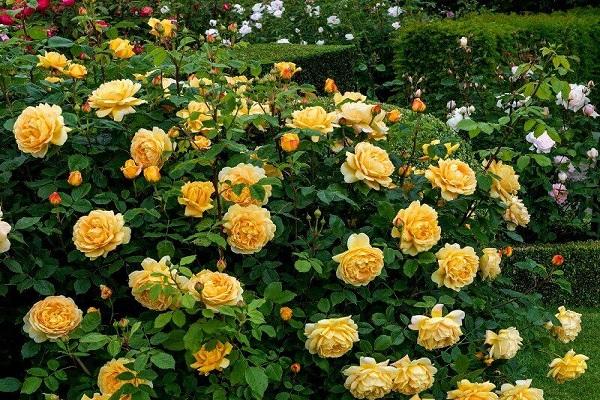
William Sheakespeare 2000
Another creation by David Austin really liked him. A rose with medium-sized double crimson flowers differs in that it changes color to a lilac or lilac shade. Climbing shoots of bushes that grow more than a meter in height are covered with dull green leaves. The variety does not suffer from the cold, if it is insulated for the winter, it is immune to fungal infection. In the aroma of the flower, violet notes are felt.
New dawn
The rose, bred back in the 30s of the last century, is still happily grown in gardens. Thin lashes of the bush branch well, when placed on a support they stretch up to 5 m in height.Double pink flowers of small diameter appear completely white in the sun, darken on cloudy cold days. The buds bloom until late autumn.
The variety is accepted in Siberia, is practically not affected by diseases, it is grown as a fountain-shaped bush, when planted next to a tree, the whips originally hang from the branches. Graceful flowers fill the air with a spicy scent with fruity notes.

Westerland
Rose Westerland was bred in the late 60s by the breeder Kordes, combining shrubs of park varieties. The plant, which turned out to be winter-hardy, beautifully wraps around gazebos and arches, is used as the main element of flower beds. The Westerland rose has oblong leaves that shine with a gloss. During flowering, the branches are dotted with buds, in which the golden center, and the petals, depending on the weather, change their yellow color to apricot, pink or orange. In the garden, when the bush blooms, the air is saturated with a bright aroma.
Rosarium Uetersen
The climbing variety, bred in Germany in 1977, is planted to create hedges, gazebos and arches. At first, the plant was not successful, but with the advent of the vintage style, courtyards and garden plots began to be actively decorated with a climbing rose. The flowers, consisting of hundreds of petals, are gathered in clusters, the diameter of one corolla reaches 11-12 cm. The dark red buds brighten under the rays of the sun. The plant does not freeze at -30, but does not take root in places where water comes to the surface. The lashes of the rose stretch up to 3 m, the width of the bush is one and a half meters.
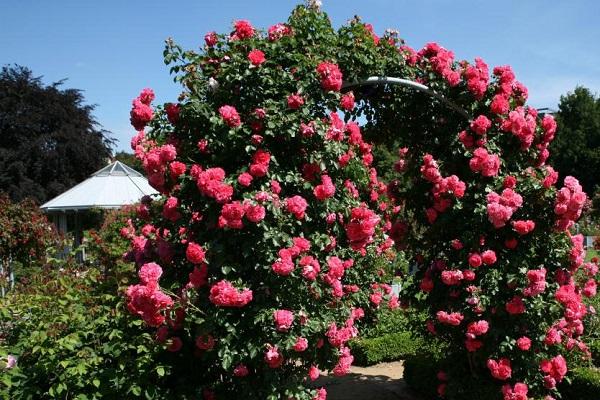
The nuances of growing outdoors
For a long time, Siberian flower growers did not dare to cultivate heat-loving crops in the garden, but with the advent of frost-resistant varieties, they began to try to plant roses in an open area. Many have succeeded.
Landing dates
In order for the flower to begin in the climate of Siberia, which is characterized by a late spring, and frosts begin early, it is necessary to plant a climbing rose when the earth warms up well, dandelions bloom. And this usually occurs not earlier than the end of May.
In the fall, it is recommended to send adult bushes to an open area, which manage to take root before the arrival of winter weather.
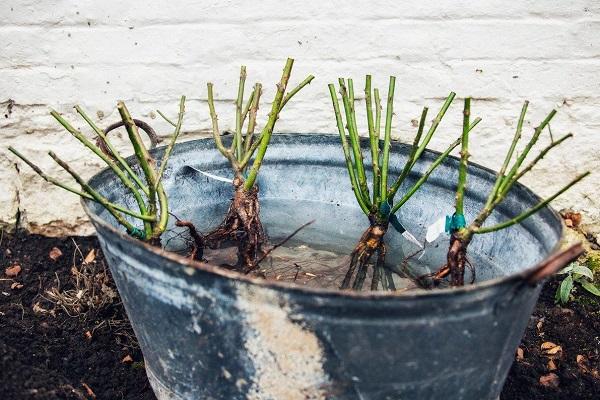
Location selection
It is also possible to create comfortable conditions for a rose in a climate where summer is short and the sun does not rise as high above the horizon as in the south. When choosing a place for a plant, you need to consider some nuances:
- A rose cannot be planted in a lowland, where the soil deeply freezes in winter.
- It is better to place the culture not in the sun, but in a light partial shade.
- The area for the flower should be protected from cold winds blowing from the north or east.
Buildings are decorated with climbing varieties, but so that the plant does not ice over and die, they plant it at least a meter from the wall. The rose does not tolerate stagnant water, it looks harmonious, it feels good next to conifers and shrubs, irises and clematis.

Preparation of planting material
You need to buy a rose at a local nursery, where varieties adapted to natural conditions are sold. It is necessary to choose a seedling for growing with strong roots and shoots, with a green stem. To make the rose take on a new place faster, move away from the resulting stress:
- Potassium permanganate powder is poured into the water, the roots are placed in the prepared solution for a day.
- The flower is soaked in the Zircon growth stimulator.
- The shoots of the plant are shortened by 20 cm, damaged branches and dried root areas are removed.
Shortly before planting, the sections are wiped with Fundazol. Roses that are sold in a pack with a lump of soil are placed in the soil along with a container made from a material that dissolves in the ground.
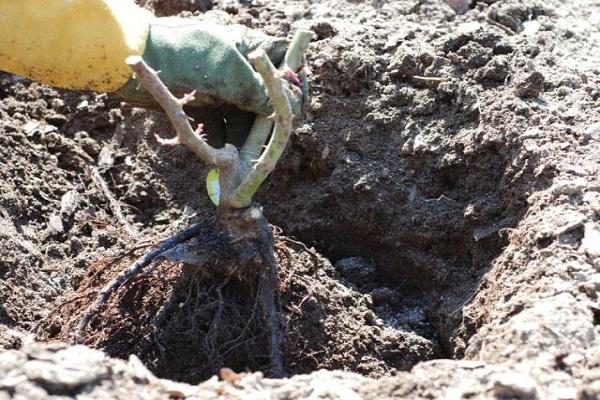
Landing rules
The site for the climbing rose is dug up, leveled, removed from the roots of the weeds. The acidic soil is diluted with ash or dolomite flour, a hole is made for a seedling up to 0.8 m deep:
- A thick layer of fine gravel or expanded clay is poured onto the bottom, river sand is added on top.
- Connect humus, peat and garden soil.
- The well is filled with a nutrient mixture by a third, put 2-3 tablespoons of superphosphate and one potassium salt.
- The rose is placed vertically in a hole, the roots are straightened and buried below the surface by 10 centimeters.
- Supporting the bush with your hand, cover the space.
The seedling is irrigated with warm water. Around the plant they compact the earth, build a small shaft. The first 2 weeks a young rose is covered from the sun's rays.
The subtleties of plant care
In order for the seedling to begin to develop rapidly, to sprout and grow stronger for winter, it must be carefully looked after.
Watering
The rose is irrigated with settled water twice a week, in the heat it is done more often. Before the onset of cold weather, it is enough to moisten the ground under the seedling once every 7 days.
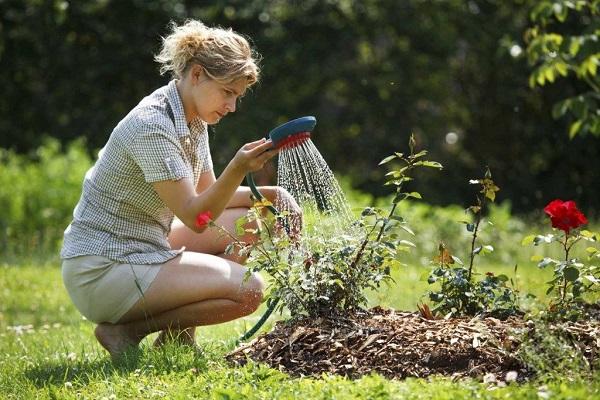
Fertilization
To feed a young plant, mullein is most often used, which contains a lot of nitrogen. One part of the organic product is mixed with 10 hours of water, infused and fertilized with a rose 20 days after planting. For the second feeding of the plant, bird droppings can be added, which takes in a concentration 2 times less than manure.
Trimming and shaping
Before the onset of frost, they get rid of weak and damaged shoots, cut off the buds and leaves. If this is not done, the rose will not survive the winter. In the spring or in the fall, they begin formative pruning. If flowers are laid on new shoots of a plant, the old ones are shortened. When buds are formed on last year's lashes, only the top is removed from them.
Preparing for the winter period
Even roses, which are bred for Siberia, need shelter during the cold season. To do this, the branches of the plant are removed from the trellis and covered with needles from above, wrapped in a material that does not allow moisture to pass through. Some gardeners build a frame for the winter and wrap it with burlap, tarpaulin or roofing felt. Dry leaves or spruce branches are laid in the space, covered with polyethylene.

Methods of protection against diseases and pests
Lack of sunny color, deficiency or excess of moisture, lack of nutritional components provoke weakening of climbing roses. Plants are affected:
- peronosporosis;
- powdery mildew;
- black spot.
For the prevention of diseases in damp weather, the bushes are recommended to be sprayed every week with the drug "Fundazol". To prevent infection by fungi, every 10 or 14 days the leaves and shoots of the rose are treated with fungicides "Zircon", "Fitosporin".
The flowering plant is strewn with microscopic aphids. If spraying with a solution of tobacco dust and laundry soap did not help to cope with insects, the home remedy is replaced with chemical insecticides in the form of Aktara, Karbofos, Aktellik.
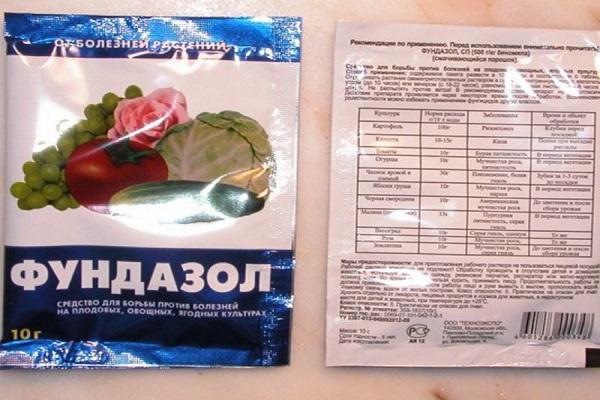
Reproduction of roses in Siberia
Curly varieties are not bred with seeds. Seedlings often do not appear at all, and sometimes a rosehip grows, which blooms after 3 or 4 years. The culture is propagated by grafting, but such a complex method is only possible for experienced gardeners.
The easiest way is to breed a rose with cuttings, harvest them in the summer, lignified shoots are cut in the fall and kept in a cool place, folded in a plastic bag until spring.
On a green cutting of a plant, which is shortened to 15 cm, up to 3 buds are left, all the leaves located below are cut off. The substrate is prepared from garden and turf soil by adding sand to the mixture. The soil is scalded with boiling water or heated in the oven.
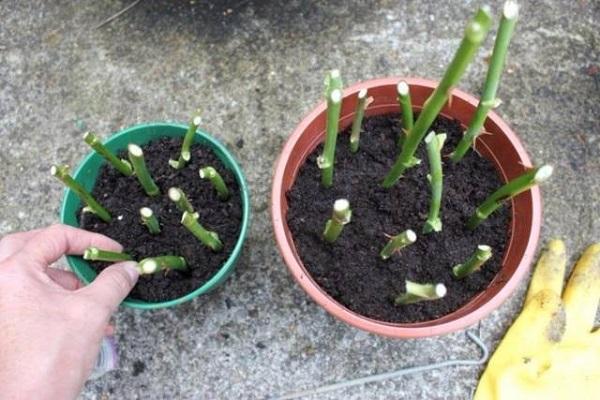
On lignified shoots of a plant 25 or 30 cm long, a straight cut is made at the top, and at an angle below, up to 5-6 internodes and a couple of leaves are left. Rose cuttings are dipped for a day in a growth stimulator, then stuck into the substrate to a depth of about 50 mm at an angle. The soil is moistened, and the shoots are insulated with a film.
If the cuttings of the plant are regularly sprayed with water from a spray bottle, ventilated, after 10 days roots appear, and the coating is removed.
For growing a rose by layering:
- For an annual plant, choose a lower branch no shorter than a meter in length.
- Above the kidneys, small incisions are made.
- A groove is dug around the bush, which is moistened, and humus is poured onto the bottom.
- A rose shoot is placed in the trench, fixed with wire, covered with earth.
- Pegs are hammered near the plant, a film is stretched, a greenhouse is created.
Cuttings that have taken root are transplanted to an open area, fed. To give the rose a decorative look, when the bush grows, the branches are shortened.
